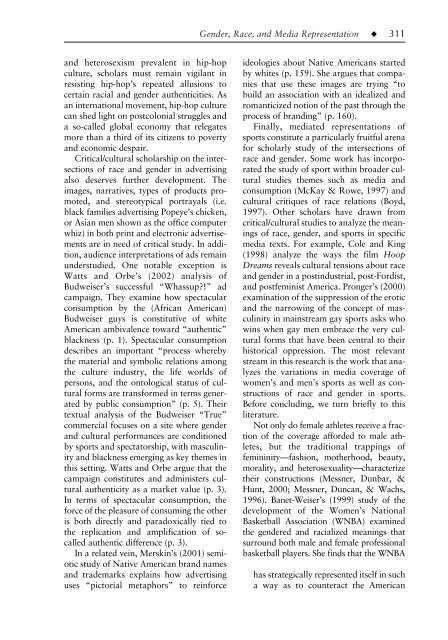Gender, race, and media representation - afghan
Gender, race, and media representation - afghan
Gender, race, and media representation - afghan
Create successful ePaper yourself
Turn your PDF publications into a flip-book with our unique Google optimized e-Paper software.
16-Dow-4973.qxd 6/11/2006 1:42 PM Page 311<br />
<strong>and</strong> heterosexism prevalent in hip-hop<br />
culture, scholars must remain vigilant in<br />
resisting hip-hop’s repeated allusions to<br />
certain racial <strong>and</strong> gender authenticities. As<br />
an international movement, hip-hop culture<br />
can shed light on postcolonial struggles <strong>and</strong><br />
a so-called global economy that relegates<br />
more than a third of its citizens to poverty<br />
<strong>and</strong> economic despair.<br />
Critical/cultural scholarship on the intersections<br />
of <strong>race</strong> <strong>and</strong> gender in advertising<br />
also deserves further development. The<br />
images, narratives, types of products promoted,<br />
<strong>and</strong> stereotypical portrayals (i.e.<br />
black families advertising Popeye’s chicken,<br />
or Asian men shown as the office computer<br />
whiz) in both print <strong>and</strong> electronic advertisements<br />
are in need of critical study. In addition,<br />
audience interpretations of ads remain<br />
understudied. One notable exception is<br />
Watts <strong>and</strong> Orbe’s (2002) analysis of<br />
Budweiser’s successful “Whassup?!” ad<br />
campaign. They examine how spectacular<br />
consumption by the (African American)<br />
Budweiser guys is constitutive of white<br />
American ambivalence toward “authentic”<br />
blackness (p. 1). Spectacular consumption<br />
describes an important “process whereby<br />
the material <strong>and</strong> symbolic relations among<br />
the culture industry, the life worlds of<br />
persons, <strong>and</strong> the ontological status of cultural<br />
forms are transformed in terms generated<br />
by public consumption” (p. 5). Their<br />
textual analysis of the Budweiser “True”<br />
commercial focuses on a site where gender<br />
<strong>and</strong> cultural performances are conditioned<br />
by sports <strong>and</strong> spectatorship, with masculinity<br />
<strong>and</strong> blackness emerging as key themes in<br />
this setting. Watts <strong>and</strong> Orbe argue that the<br />
campaign constitutes <strong>and</strong> administers cultural<br />
authenticity as a market value (p. 3).<br />
In terms of spectacular consumption, the<br />
force of the pleasure of consuming the other<br />
is both directly <strong>and</strong> paradoxically tied to<br />
the replication <strong>and</strong> amplification of socalled<br />
authentic difference (p. 3).<br />
In a related vein, Merskin’s (2001) semiotic<br />
study of Native American br<strong>and</strong> names<br />
<strong>and</strong> trademarks explains how advertising<br />
uses “pictorial metaphors” to reinforce<br />
<strong>Gender</strong>, Race, <strong>and</strong> Media Representation–––◆–––311<br />
ideologies about Native Americans started<br />
by whites (p. 159). She argues that companies<br />
that use these images are trying “to<br />
build an association with an idealized <strong>and</strong><br />
romanticized notion of the past through the<br />
process of br<strong>and</strong>ing” (p. 160).<br />
Finally, <strong>media</strong>ted <strong>representation</strong>s of<br />
sports constitute a particularly fruitful arena<br />
for scholarly study of the intersections of<br />
<strong>race</strong> <strong>and</strong> gender. Some work has incorporated<br />
the study of sport within broader cultural<br />
studies themes such as <strong>media</strong> <strong>and</strong><br />
consumption (McKay & Rowe, 1997) <strong>and</strong><br />
cultural critiques of <strong>race</strong> relations (Boyd,<br />
1997). Other scholars have drawn from<br />
critical/cultural studies to analyze the meanings<br />
of <strong>race</strong>, gender, <strong>and</strong> sports in specific<br />
<strong>media</strong> texts. For example, Cole <strong>and</strong> King<br />
(1998) analyze the ways the film Hoop<br />
Dreams reveals cultural tensions about <strong>race</strong><br />
<strong>and</strong> gender in a postindustrial, post-Fordist,<br />
<strong>and</strong> postfeminist America. Pronger’s (2000)<br />
examination of the suppression of the erotic<br />
<strong>and</strong> the narrowing of the concept of masculinity<br />
in mainstream gay sports asks who<br />
wins when gay men emb<strong>race</strong> the very cultural<br />
forms that have been central to their<br />
historical oppression. The most relevant<br />
stream in this research is the work that analyzes<br />
the variations in <strong>media</strong> coverage of<br />
women’s <strong>and</strong> men’s sports as well as constructions<br />
of <strong>race</strong> <strong>and</strong> gender in sports.<br />
Before concluding, we turn briefly to this<br />
literature.<br />
Not only do female athletes receive a fraction<br />
of the coverage afforded to male athletes,<br />
but the traditional trappings of<br />
femininity—fashion, motherhood, beauty,<br />
morality, <strong>and</strong> heterosexuality—characterize<br />
their constructions (Messner, Dunbar, &<br />
Hunt, 2000; Messner, Duncan, & Wachs,<br />
1996). Banet-Weiser’s (1999) study of the<br />
development of the Women’s National<br />
Basketball Association (WNBA) examined<br />
the gendered <strong>and</strong> racialized meanings that<br />
surround both male <strong>and</strong> female professional<br />
basketball players. She finds that the WNBA<br />
has strategically represented itself in such<br />
a way as to counteract the American




